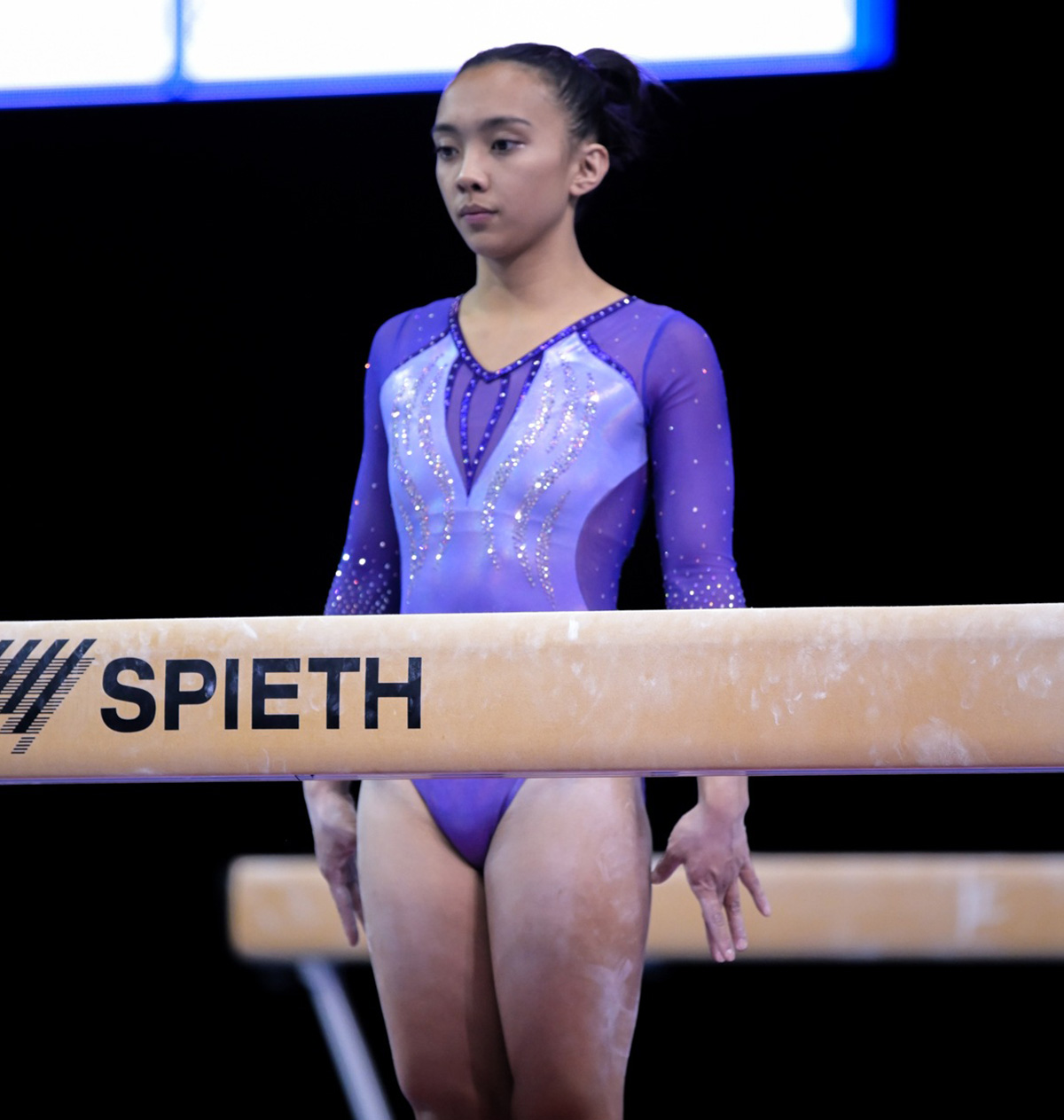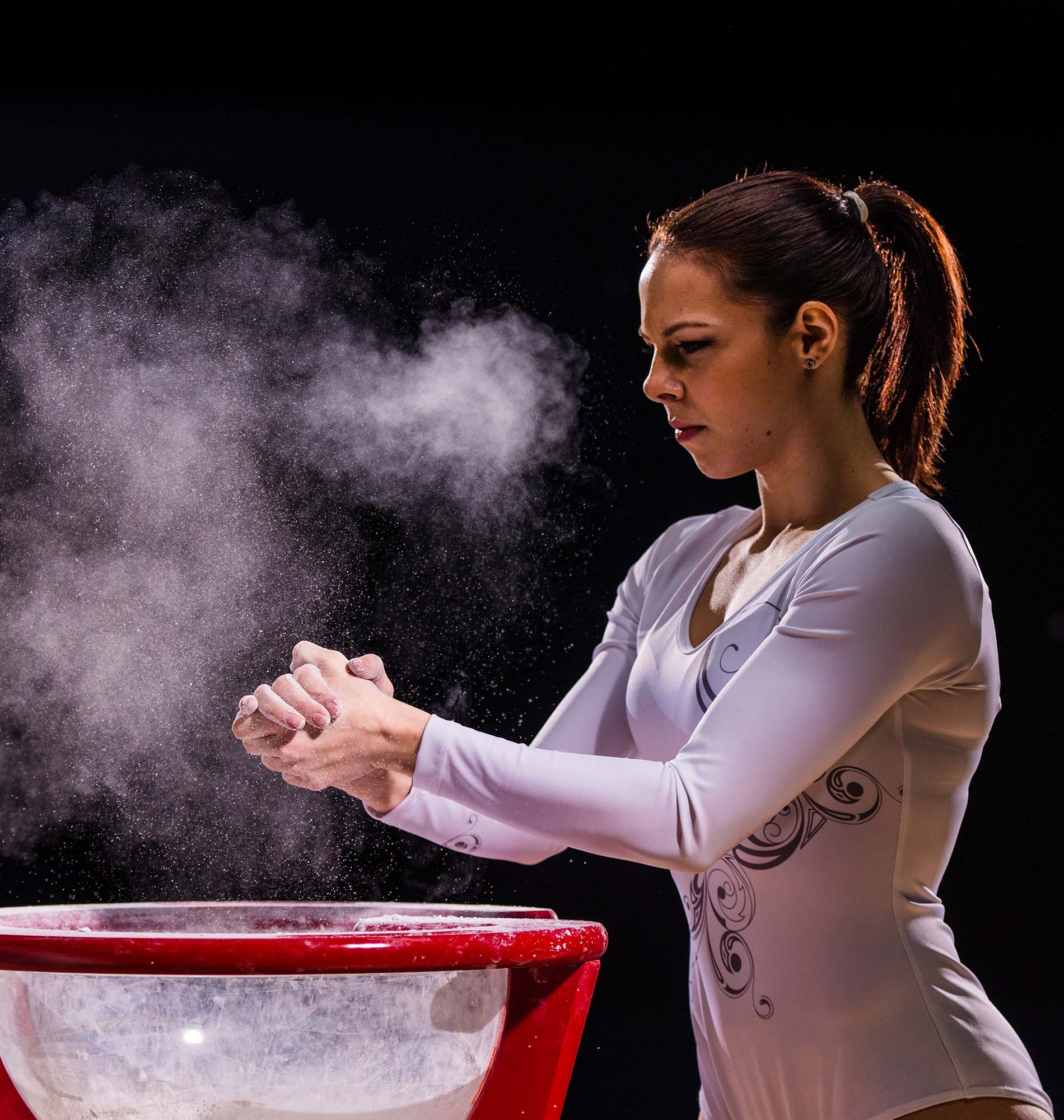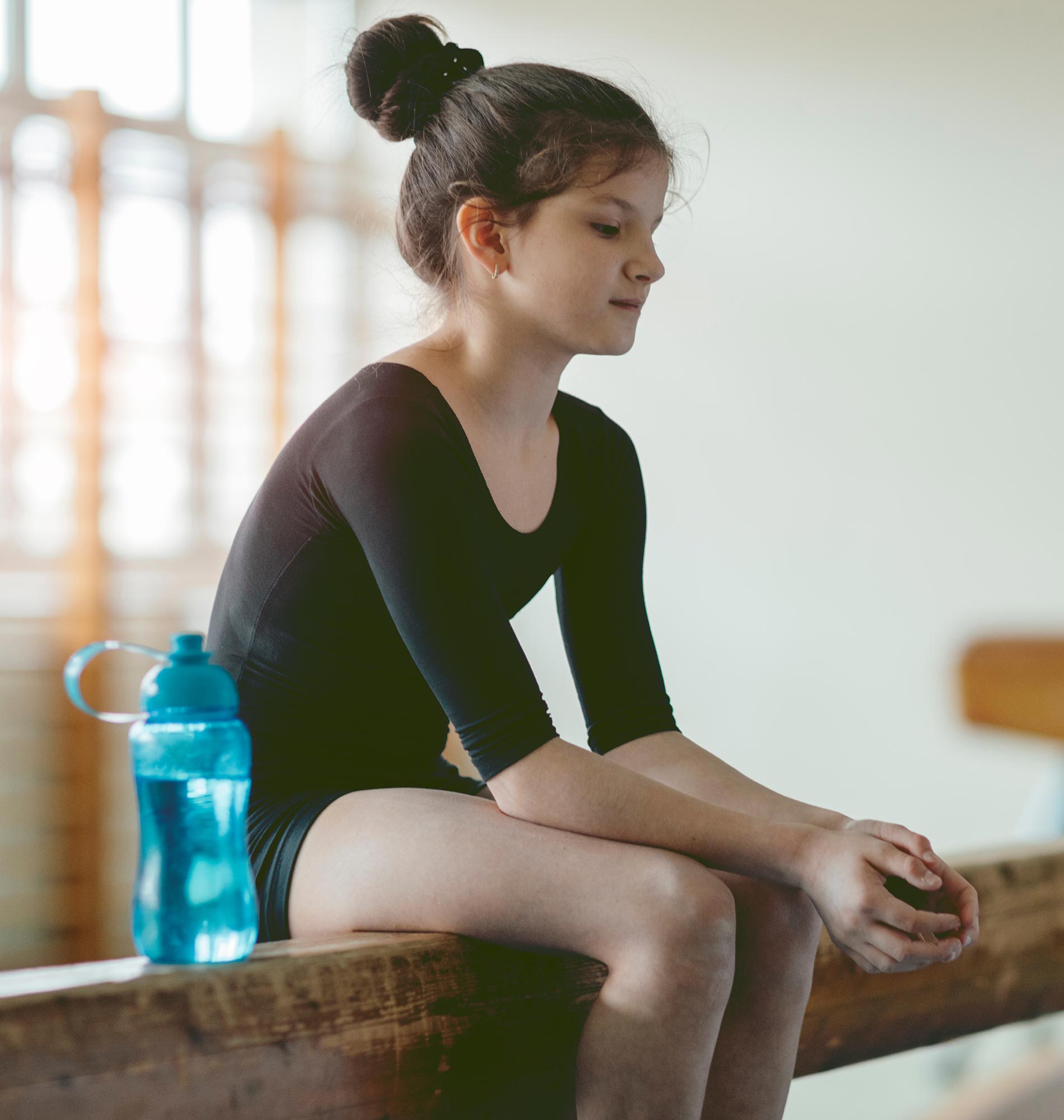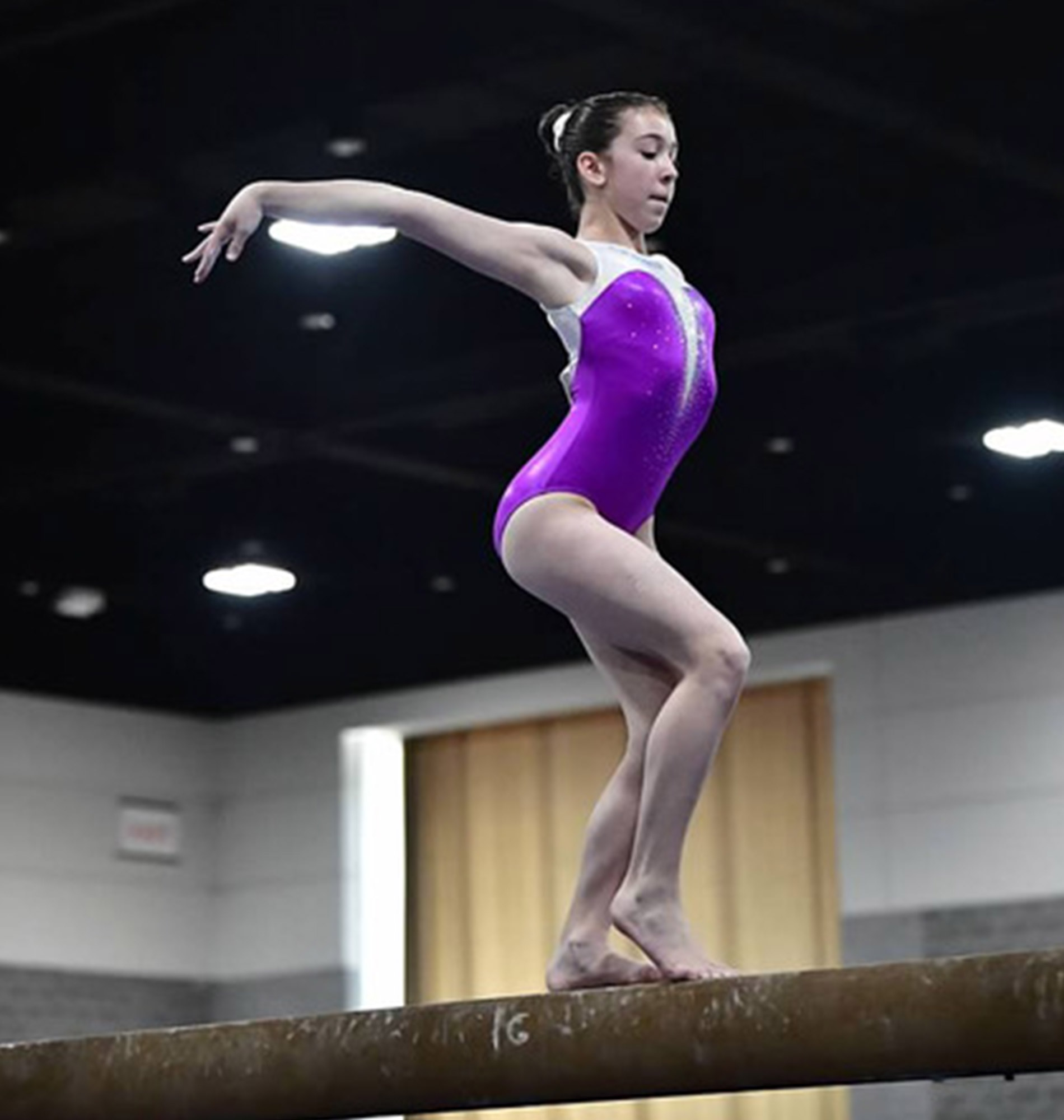1
Cervical Spine Injury
Epidemiology: Can occur at any age.
Mechanism of Injury/Description: A cervical spine injury is the result of a direct blow or injury to the neck.
Signs/Symptoms: The gymnast will have acute pain in their neck (cervical spine) and may have numbness or tingling. **If there is any loss of sensation/feeling/numbness, 9-1-1 should be called immediately and as long as the gymnast is in a safe position/area the gymnast should not be moved until EMS or a medical provider has arrived.
Diagnosis: If a cervical spine injury is suspected, and a trained medical provider is available stabilize the head and neck immediately, then log roll (or check your States regulations on emergency training/protocols), so the athlete is prone; finally, depending on your State’s protocols, and if allowed/trained use a spine board, and transport the gymnast to the local emergency department. Once transported, further imaging may be ordered (ex: x-ray, MRI, CT scan).
Treatment: Transportation to your local emergency department.
Prevention: To prevent cervical spine injuries practice proper landing techniques, proper matting and spotting, and neck strengthening.
Gymnastics Medical Provider PEARLS: Know your States individual laws on spine boarding. Talk with gymnastics facilities about practicing spine boarding and cervical spine injury extraction from the foam pit.
Gymnast, Parent, and Coach PEARLS: Ask your coaches/gymnastics facility if they have an Emergency Action Plan (EAP). This plan should be in place for all gymnastic facilities and competition venues.
2
Concussion
Epidemiology: Can occur at any age.
Mechanism of Injury/Description: A direct blow/hit to the head/neck/face, or any impact force to the head can cause a concussion. This injury is also known as a mild traumatic brain injury (TBI).
Signs/Symptoms: The gymnast will experience headaches, dizziness, nausea/vomiting, balance problems, vision changes, difficulty concentrating, feeling “in a fog”, irritability, and changes to sleep patterns.
Diagnosis: A concussion can be diagnosed by physical exam with testing of Cranial nerves/concussion screen, BESS testing, and/or a sideline evaluation (SCAT 5). A CT scan or MRI may be ordered depending on severity and duration of the gymnast’s signs/symptoms.
Treatment: Immediately remove the gymnast from practice or competition and have the athlete do cognitive and physical rest for 24-48 hours and see a medical provider. Once you have been seen by a medical provider and receive clearance, a gradual progression back into gymnastics should be performed. Please see USAG Concussion Information.
Prevention: To prevent a concussion practice neck strengthening exercises and consider having each gymnast do a baseline IMPACT test prior to the start of each season. Check with local medical providers to see if they are offering this testing.
Gymnastics Medical Provider PEARLS: Gymnastics requires a significant amount of proprioception and balance and with a concussion this can sometimes take gymnasts longer to progress back in. Review over the guidelines and information put together by USA Gymnastics (link above) and see our blog on Concussion education.
Gymnast, Parent, and Coach PEARLS: If a concussion is suspected, stop the practice/competition and have your gymnast see a medical provider for evaluation.
Complications of concussion:
- Second Impact Syndrome
- Post concussion Syndrome
- Intracranial hemorrhage
- CTE (chronic traumatic Encephalopathy)
For more information, read our blog on Concussion Education.
2
Concussion
Epidemiology: Can occur at any age.
Mechanism of Injury/Description: A direct blow/hit to the head/neck/face, or any impact force to the head can cause a concussion. This injury is also known as a mild traumatic brain injury (TBI).
Signs/Symptoms: The gymnast will experience headaches, dizziness, nausea/vomiting, balance problems, vision changes, difficulty concentrating, feeling “in a fog”, irritability, and changes to sleep patterns.
Diagnosis: A concussion can be diagnosed by physical exam with testing of Cranial nerves/concussion screen, BESS testing, and/or a sideline evaluation (SCAT 5). A CT scan or MRI may be ordered depending on severity and duration of the gymnast’s signs/symptoms.
Treatment: Immediately remove the gymnast from practice or competition and have the athlete do cognitive and physical rest for 24-48 hours and see a medical provider. Once you have been seen by a medical provider and receive clearance, a gradual progression back into gymnastics should be performed. Please see USAG Concussion Information.
Prevention: To prevent a concussion practice neck strengthening exercises and consider having each gymnast do a baseline IMPACT test prior to the start of each season. Check with local medical providers to see if they are offering this testing.
Gymnastics Medical Provider PEARLS: Gymnastics requires a significant amount of proprioception and balance and with a concussion this can sometimes take gymnasts longer to progress back in. Review over the guidelines and information put together by USA Gymnastics (link above) and see our blog on Concussion education.
Gymnast, Parent, and Coach PEARLS: If a concussion is suspected, stop the practice/competition and have your gymnast see a medical provider for evaluation.
Complications of concussion:
- Second Impact Syndrome
- Post concussion Syndrome
- Intracranial hemorrhage
- CTE (chronic traumatic Encephalopathy)
For more information, read our blog on Concussion Education.
3
Corneal Abrasion
Epidemiology: Can occur at any age.
Mechanism of Injury/Description: A corneal abrasion occurs by having an injury to the eye’s cornea which can be from chalk or another particle that enters the eye and scratches/damages the cornea.
Signs/Symptoms: The gymnast will experience pain in the eye, redness, and blurred vision.
Diagnosis: A corneal abrasion is diagnosed by physical exam and fluorescent stain with UV light.
Treatment: Treatment for a corneal abrasion includes topical NSAIDs, antibiotics, eye patch, and a non-urgent referral to ophthalmologist.
Prevention: To prevent this injury avoid foreign objects in eyes.
Gymnastics Medical Provider PEARLS: Have a fluorescent stain with UV light available in your medical kit when covering a gymnastics competition. Also consider having saline to flush the eye out.
Gymnast, Parent, and Coach PEARLS: If you suspect something has gone into your eye, stop what you are doing, tell an adult, wash your hands, and then go to an area where you can flush your eye out with water gently. If this does not work or you have worsening pain or redness see a medical provider.
4
Hyphema
Epidemiology: Can occur at any age.
Mechanism of Injury/Description: A hyphema is when blood goes into the anterior chamber of the eye from a direct blow/hit to the eye.
Signs/Symptoms: The gymnast will experience eye pain, blurred vision, and red fluid accumulating in the eye.
Diagnosis: This is diagnosed by physical exam and medical emergency/transport to an ophthalmologist.
Treatment: Eye patch and immediate medical emergency/transport to an ophthalmologist.
Prevention: Prevention of a hyphema is to avoid getting hit in the eye.
Gymnastics Medical Provider PEARLS: This usually occurs with an acute fall so make sure you do a full trauma exam/workup to rule out other serious injuries. Also, treatment usually begins by elevating the head of the bed to 30 degrees.
Gymnast, Parent, and Coach PEARLS: This is a medical emergency. If this is seen in a gymnast after a trauma/hit to the eye immediately have the gymnast go to the emergency department.
5
Orbital Wall Fracture
Epidemiology: Can occur at any age.
Mechanism of Injury/Description: An orbital wall fracture occurs from a direct blow or hit to the eye/orbital region causing a fracture and then the inability to move your eye.
Signs/Symptoms: The gymnast will experience pain, blurry or double vision, swelling/inflammation, and an inability to move the eye.
Diagnosis: The diagnosis is determined by physical exam (pain, blurry or double vision, swelling/inflammation, and an inability to move the eye), and an immediate referral to an ophthalmologist.
Treatment: Treatment is an immediate referral to an ophthalmologist.
Prevention: Prevention of an orbital wall fracture is to avoid getting hit in the eye.
Gymnastics Medical Provider PEARLS: This usually occurs with an acute fall/hit so make sure you do a full trauma exam/workup to rule out other serious injuries.
Gymnast, Parent, and Coach PEARLS: This is a medical emergency. If this is seen in a gymnast after a trauma/hit to the eye immediately have the gymnast go to the emergency department.
6
Heat Exhaustion
Epidemiology: Can occur at any age and is the most common type of heat-induced condition.
Mechanism of Injury/Description: Heat exhaustion is defined as a core temperature of less than 102.2 degrees F (39 degrees C) and no central nervous system dysfunction. This can be a precursor to heat stroke.
Signs/Symptoms: Nausea, vomiting, and profuse sweating are signs and symptoms of heat exhaustion.
Diagnosis: Determined by physical exam with a core temperature of less than 102.2 degrees F (39 degrees C).
Treatment: Treatment for heat exhaustion includes IV hydration, table salts, and cooling.
Prevention: To prevent heat exhaustion stay hydrated, check temperatures in gymnastics facilities, and allow time for breaks/rest when temperatures increase.
Gymnastics Medical Provider PEARLS: Heat exhaustion can be a precursor to heat stroke. Watch carefully for signs and symptoms of gymnasts during summer workouts, as well as the room temperature inside the gymnastics facility in the summertime.
Gymnast, Parent, and Coach PEARLS: Especially during summer and warm months make sure your gymnast has plenty of water and sports drinks (electrolytes) as well as explain the signs and symptoms of heat stroke to your gymnast so that he/she can understand this and look for this not only for themselves but also for their teammates.
7
Heat Stroke
Epidemiology: Can occur at any age and is a MEDICAL EMERGENCY.
Mechanism of Injury/Description: Heat stroke is described as hyperthermia and central nervous system dysfunction from “over heating.” The gymnast’s body temperature will be above 104 degrees F (40.5 degrees Celsius).
Signs/Symptoms: Increased heart rate, confusion, seizures, and lack of sweating are all signs and symptoms of heat stroke.
Diagnosis: Heat stroke is diagnosed by a physical exam which shows increased heart rate, confusion, seizures, lack of sweating, and a temperature above 104 degrees F (40.5 degrees Celsius).
Treatment: The treatment for heat stroke is to lower the gymnast’s body temperature with ice bath submersion, cooling blanket, fanning, and IV hydration.
Prevention: To prevent heat stroke stay hydrated, check temperatures in gymnastics facilities, and allow time for breaks/rest when temperatures increase.
Gymnastics Medical Provider PEARLS: This is a MEDICAL EMERGENCY. Have an emergency action in place if this were to occur.
Gymnast, Parent, and Coach PEARLS: This is a MEDICAL EMERGENCY. Especially during summer and warm months make sure your gymnast has plenty of water and sports drinks (electrolytes) as well as explain the signs and symptoms of heat stroke to your gymnast so that he/she can understand this and look for this not only for themselves but also for their teammates.





